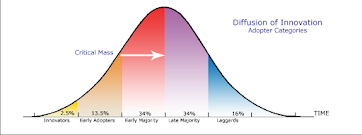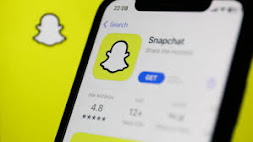Snapchat: Through the Lens of Innovation
Many of us use Snapchat throughout the day to communicate with friends and family all over the world. Snapchat was the new social media in 2011 when it launched. Since 2011 it has become a main source of communication for many young people, however not everyone is as willing to adopt Snapchat as a main form of communication. Why did the younger audience rush to download the app, while the older generation was more hesitant? The answer to this question is assisted by Roger's Diffusion of Innovations Theory. This theory touches on the reasoning for why some technological innovations and why some ideas work and last over time in comparison to others. The five main categories of people that are a part of this theory are the pioneers, the early adopters, the early majority, the late adopters, and the laggards. When applying this graph and these categories to Snapchat, one must take into consideration what Snapchat had to offer to certain demographics at the time.
For starters, the pioneers of this category were Stanford students Bobby Murphy, Evan Spiegel, and Reggie Brown. They created the platform Snapchat under the original name of Picaboo. They created Snapchat in the first place, because they wanted to design a social media app that was focused on having content that disappeared. This was a novel idea that would most likely be a huge success, because many people dislike the idea of how permanent social media is. Therefore, with some of the younger generation already on board, many investors tried to jump on the opportunity to make a lot of money as Snapchat took off. According to the website linked above, these investors would be described as early adopters and included Lightspeed Ventures, Benchmark Capital, and Institutional Venture Partners.
Overall, the younger generation at the time would be considered the early majority, because they were on the hunt for a new form of social media. According to the website Business Chef , "parents and other members of older generations have a dominant presence on Facebook, causing younger users to seek out a new platform." I'm sure they heard some of their friends talking about this new app and wanted to check it out for themselves, especially with the fact that you wouldn't see your parents or grandparents on the app most likely!
The reason why you wouldn't see this older generation on the app was because they were content with using Facebook. This older generation didn't necessarily feel the need to communicate with their friends and family all the time, but instead used Facebook more as just a check-in service or if they wanted to post themselves, they could, and it would be up permanently. I consider Snapchat a service for constant updates, and I just find that the older generation doesn't have time to constantly be posting and snapping others back. Therefore, I would consider the older generation to be labeled as late adopters, because many didn't understand the point. For instance, I've gone over numerous times with my parents and grandparents about how you take pictures of yourself and send them to friends or post on your story, but eventually all the content goes away after a certain period. My family members couldn't grasp the concept and found it essentially pointless if you couldn't go back and view a picture or video whenever you wanted to. They also didn't like the idea of having to save your chats or messages, because they didn't understand why they wouldn't just stay forever. However, some people in this category ended up eventually getting Snapchat for various reasons. Some may have been forced by the members of the younger generation in their life who wanted them to get it to stay in touch, because the younger generation has stopped using Facebook in many instances. Another reason for getting it could be since members of the older generation didn't want to feel like they were missing out or were getting too old to keep up with the trends. There is also the possibility that some are business owners who felt obligated to get Snapchat to reach a younger target audience. In this case, they would probably hire younger people to control this form of social media and other types for their business, especially if they were unfamiliar with it or didn't understand its purpose.
Snapchat has been able to last over the years as one of the hottest apps on the market because they have made many updates to the app to keep pleasing their users. They make updates to stay relevant and to start the process over on the graph which represents the stages of a technology or an idea's relevance. If they didn't make these updates, their consumers would become bored and would want to use a new app instead. As consumers get older, their love for Snapchat may die out as they learn about the negative health benefits of using social media so much. Therefore, Snapchat must continue to come out with new additions to their app to stay relevant to new generations, because the old ones will mature and will realize that the benefits of communicating with friends and family constantly doesn't outweigh the fact that many have headaches from looking at their phones too much, lack speaking skills, have neck or back pain, etc..







No comments:
Post a Comment